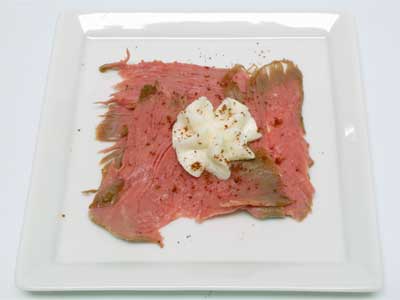June 20, 2011
Amuse-Bouche

agneau à la mayonnaise
(cold lamb with mayonnaise)
Of all the muscles in all the barnyard animals that we commonly eat, the tenderloin is, at the same time, the best and the worst piece of meat that these animals have to offer. The best because it is the most tender, and the worst because it either lacks flavor or sometimes even has an off flavor. Both are probably a function of where the cut is located on the animal.
When I ask my students, “What part of the animal does the tenderloin come from?” the most common two answers are a cryovac bag and a plastic-wrapped foam tray. I try to explain to them that it is a muscle that starts narrow at the last rib and traverses the entire lumbar spine, and is between the lateral process of the spine and the peritoneum. I tell them that it is often sold with the chain or side meat attached, but that this is really a separate, less desirable, muscle. I also tell them that the tenderloin does very little work and so is very tender. The only serious connective tissue is the wrapping of the muscle where it was not connected to the spine, a membrane often referred to as the silverskin.
By now they’ve become thoroughly bored and are diligently tweeting this condition to the world, or posting their impressions of the latest Desperate Housewives episode to their thousand closest friends on Facebook. And I haven’t even started to tell them about the various cuts produced from a tenderloin, and that the names and quality have evolved over the years, or that when you buy a filet with bacon wrapped around it you are paying filet prices for cheap bacon. In reality, a tenderloin can produce very tasty, tender cuts of meat when harvested from the right animal and cooked properly.
For most of us, if we can buy a whole tenderloin, it is probably either bovine or porcine. Ovine tenderloins are not readily available to the average customer outside of lamb exporting countries. When I visited wholesale meat markets in Australia, I saw racks and racks of tenderloins, often at amazingly cheap prices. If I want one here in Northern California, I usually have to order a bag from a specialty butcher at an exorbitant price. Luckily, about once a month I teach a class in lamb butchering, and I can save a few tasty morsels for my use at home.
In the United States, lambs are mostly butchered with a band saw which reduces labor significantly but means that certain cuts are generally unavailable. This is the case with the tenderloin, which shows up in your grocery basket as one of the two muscles in a loin chop. Should you have the opportunity to purchase a few lamb tenderloins, snatch them up. If you have enough for a main course, you can just salt and pepper them, and then fry them very quickly in a little oil in a very hot pan. The center should be quite rare and the outside well browned.
However, if you are limited to only two, like I am, they can be used for an amazing amuse-bouche. (I’m limited to two because that’s how many I can harvest from a single lamb.) For me, a typical 25-kg (55-lb) lamb with provide me with two 100-g (3-1⁄2-oz) tenderloins. From each of these I can produce four amuse-bouche-sized servings.
This particular amuse-bouche is inspired by the traditional French custom of serving fresh mayonnaise with cold leg of lamb. For the lamb, I season it with fine salt and freshly ground black pepper. The tenderloin is positioned very straight in a plastic bag and vacuum sealed. This is then poached in 55 °C (131 °F) water for a time appropriate to the thickness. When cooked, the lamb is removed from the bag, toweled dry, and seared very quickly in a very, very hot cast iron pan. The tenderloin is then just set on a plate and put into the refrigerator to cool. This can be done long in advance of the meal.
The mayonnaise can also be made far in advance of plating. For this lamb, I like to make a very subtle mayonnaise subversive out of egg whites and a neutral oil. For this use, a little extra salt will help bring out the flavor of both the mayonnaise and the lamb.
A few hours before serving, I slice the meat. With only a small amount per serving, it is critically important to slice the meat very thin. Since I’m right-handed, I lay the meat on my cutting board so that the thin tip is to my left and the thick head to my right. I start cutting at the tip with the knife almost parallel to my cutting board. I support the meat with my left hand, with my fingers out straight but slightly above the plane of my blade. I’m cutting just underneath my hand. I use the full length of my blade for each stroke and move it through the meat, almost without pressing. The slices must be almost paper thin and very long. As each slice is made, it is arranged right away on its serving plate. I try to get four slices for each plate and arrange them in a square with an open center. The plates should be individually and tightly covered with plastic wrap, and then refrigerated.
To finish the plating, I place the mayonnaise in a pastry bag fitted with a star tip and pipe a mound in the center of each lamb arrangement. The dish is completed with a sprinkling of something red, such as smoked paprika, chipotle chili powder, or piment d’Espelette. Alternatively, I can go green and use some micro-green leaves or finely minced green onion tops.
© 2011 Peter Hertzmann. All rights reserved.
